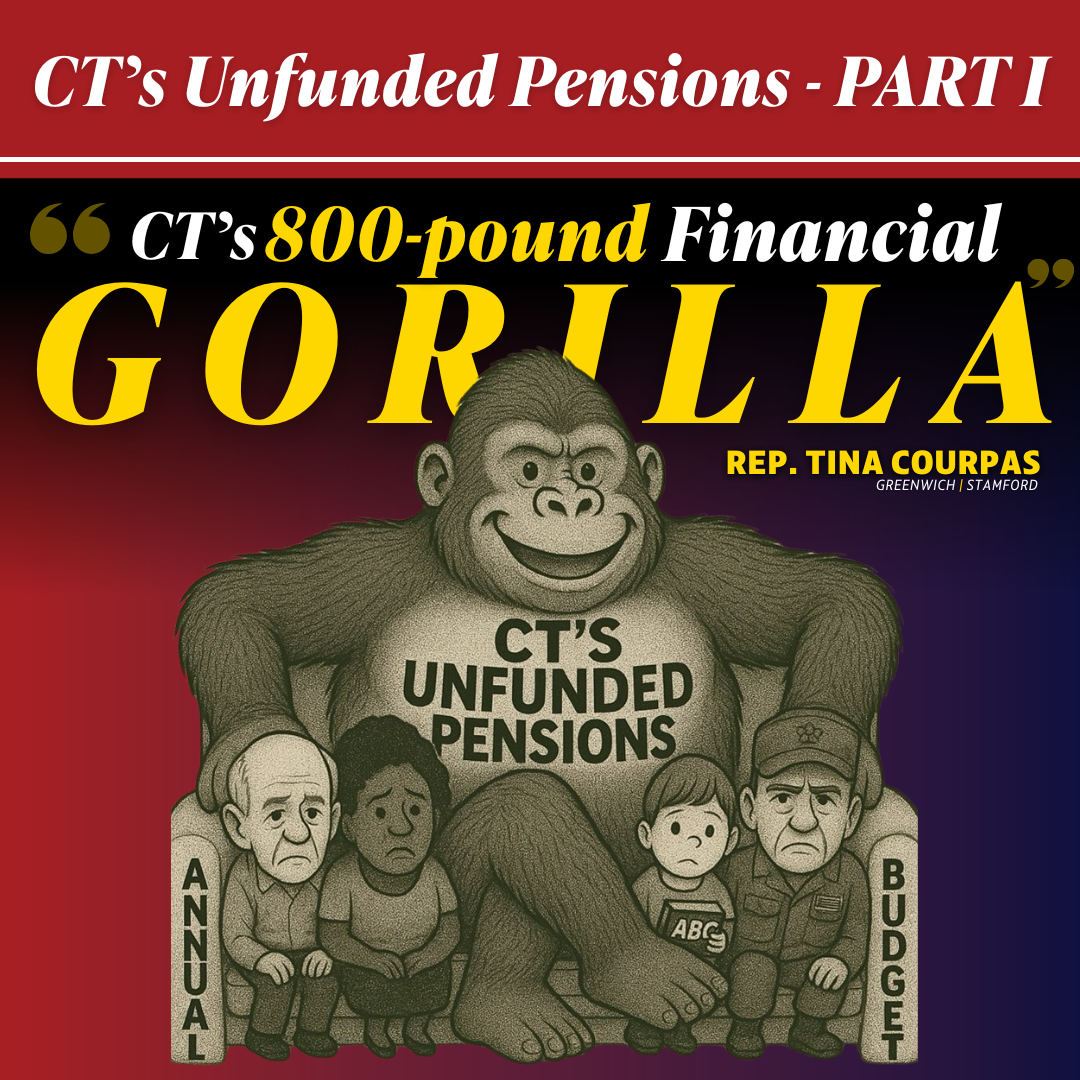CT's Unfunded Pensions - PART I

Key Takeaways
- State faces crushing long‑term liabilities that threaten fiscal stability.
- Pension and retiree health costs drive most of the budget pressure.
- Lawmakers must pursue spending reforms and sustainable benefit changes.
- Taxpayers risk higher rates without structural fiscal discipline and oversight.
Unfunded pensions are Connecticut’s 800-pound gorilla and arguably the most important financial issue facing our state. I am virtually certain that when citizens are fully aware of the magnitude of this issue, they will agree: Connecticut must stay the course on which it embarked in 2017 when the Fiscal Guardrails were implemented and fix the state’s unfunded pension problem as soon as possible.
Every year, CT makes approximately $6 billion in cash payments to retired state employees, which represents a higher percentage of our annual budget than pension payments represent for any other state. So, while unfunded pension liabilities seem like a can we can “kick down the road” and hope for a resolution at some fictitious future date, they are not. These unfunded liabilities take a big bite out of our state budget every year. That is a reason for all of us to care, now.
KEY POINTS ON PENSIONS:
- State retiree pensions and benefits are legally guaranteed cash payments to state employees who have retired. State employees (government workers, state troopers, teachers, etc.) earn a paycheck and receive health benefits while they are employed. When they retire, they receive a (reduced) paycheck and health benefits until death.
- Some states have put aside enough pension assets to fund these fixed pension liabilities. CT has not. At the end of FY2023, the state had approximately $103 billion of total projected pension liabilities (this number grows every year!) and only approximately $50 billion in pension assets to support them. Because of this large disparity, it is almost impossible for our pension assets to generate enough income to fund the annual payments of approximately $6 billion made to state retirees every year. Each year, taxpayers must make up the shortfall. Fully funded pension plans (plans for which plan assets>= plan liabilities) basically “support themselves” as earnings on plan assets pay for annual payments to retirees; CT’s pension plan does not. (1)
- Retiree pensions and benefits represent approx. 25% of our annual state general fund every year.... 25%. The state made approx. $6 billion in cash payments to retirees in 2024, and our General Fund (pays most of the state’s ongoing expenses) was $23 billion. Relative to its budget, CT spends more on pensions than any other state according to the National Association of Retirement Administrators. We rank #1 out of 50 states. This is a contest where you want to place #50. (2)(3)
- Shouldn’t state employees receive adequate compensation and pension for work well done? ABSOLUTELY. That’s why we must fix the unfunded problem, so we have enough money to pay pensioners what they are rightly due.
- We must also examine how Connecticut is growing the problem. Connecticut’s state employee salaries have outpaced private sector wages in Connecticut since 2019. Public salaries during that time are up 33%, while private salaries are up 23%. Higher salaries result in higher pensions. We cannot keep growing the state’s pension liability faster than the taxpayers’ ability to pay for it. (4)
- Because of CT’s Fiscal Guardrails, we have made progress, but not as much as people might think. Due in large part to our bipartisan Fiscal Guardrails, CT has added $11 billion to our pension assets since 2019. Thanks to those payments, CT’s “funded ratio” (pension assets/pension liabilities) for the largest state employee retirement plan (SERS) has improved from 36% to 55% over the last eight years. (5) This is great progress. However, between 2019-2024, it is reported that we have also added $ 9 billion to our liabilities. So, we have been bailing ourselves out of a leaky boat with one hand ($11 billion increase in assets) while adding more water to the boat with the other ($9 billion increase in liabilities) for a net improvement of $2 billion. (6)
- The 2025 Budget departed from the path of paying down the unfunded pension debt on which CT had embarked. In June of this year, the majority party passed a budget (every Republican and two Democrats voted no) which raised the “Volatility Cap” by $150 million in FY25, $600 million in FY26, and $632 million in FY27. Cutting through the “government budget speak,” raising the Volatility Cap allowed the legislature to spend an additional $1.2 billion of funds that would normally have gone towards funding the state’s pension plan under the Fiscal Guardrails. This diversion of funds will cost the state much more in the long run. (7) In my opinion, this departure from the spirit and progress of the Guardrails was a big mistake.
Unfunded Pension Liabilities are CT’s 800-pound financial gorilla. The magnitude of the dollars involved dwarfs CT’s other fiscal considerations and puts a strain on every year’s budget. We must stay the course on the Fiscal Guardrails and restore fiscal discipline in the 2026 legislative session.
SOURCES:
(1) Figures are most current available figures provided by State of Connecticut’s nonpartisan Office of Fiscal Analysis on 9/26/25 and represent totals for FY2023. Please contact Rep. Courpas for any backup needed.
(2) General Fund Balance: Click here.
(3) State and local government contributions to pensions as a percentage of all state and local government direct general spending, by state, FY 13 to FY 22. Click here.
(4) Employee wages: Click here
(5) Funded Ratio: Click here
(6) Net benefit to Pension Fund: Click here
(7) Changes to Volatility Cap: Click here